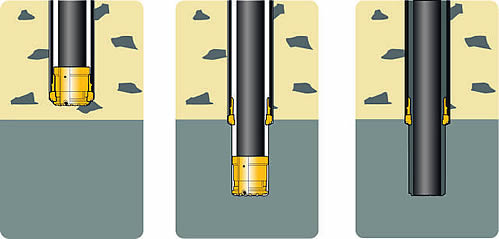Types of Casing
Based on the primary function of the casing string, there are five types of casing to be distinguished.
Stove or Surface Casing The stovepipe is usually driven to sufficient depth (15–60 ft) to protect loose surface formation and to enable circulation of the drilling fluid. This pipe is sometimes cemented in predrilled holes.
Conductor String This string acts as a guide for the remaining casing strings into the hole. The purpose of the conductor string is also to cover unconsolidated formations and to seal off over pressured formations. The conductor string is the first string that is always cemented to the top and equipped with casing head and blowout prevention (BOP) equipment.
Surface Casing This is set deeply enough to protect the borehole from caving-in in loose formations frequently encountered at shallow depths, and protects the freshwater sands from contamination while subsequently drilling a deeper hole. In case the conductor string has not been set, the surface casing is fitted with casing head and BOP.
Intermediate Casing Also called protection string, this is usually set in the transition zone before abnormally high formation pressure is encountered, to protect weak formations or to case off loss-of-circulation zones.
Depending upon geological conditions, the well may contain two or even three intermediate strings. Production string (oil string) is the string through which the well is produced.
Intermediate or production string can be set a liner string. The liner string extends from the bottom of the hole upward to a point about 150–250 ft above the lower end of the upper string.
Casing Program Design Casing program design is accomplished by two steps. In the first step, the casing sizes and corresponding bit sizes should be determined. In the second step, the setting depth of the individual casing strings ought to be evaluated. Before starting the casing program design, the designer ought to know the following basic information:
- The purpose of the well (exploratory or development drilling)
- Geological cross-sections that should consist of type of formations, expected hole problems, pore and formation’s fracture pressure, number and depth of water, oil, gas horizons Available rock bits, reamer shoes and casing sizes
- Load capacity of a derrick and mast if the type of rig has already been selected
Read Also Drilling Fluids Additives
Before starting the design, it must be assumed that the production casing size and depth of the well has been established by the petroleum engineer in cooperation with a geologist, so that the hole size (rock bit diameter) for the casing may be selected. Considering the diameter of the hole, a sufficient clearance beyond the coupling outside diameter must be provided to allow for mud cake and also for a good oil well cementing job. Field experience shows that the casing clearance should range from about 1.0 in. to 3.5 in. Larger casing sizes require greater value of casing clearance. Once the hole size for production string has been selected, the smallest casing through which a given bit will pass is next determined. The bit diameter should be a little less (0.05 in.) than casing drift diameter. After choosing the casing with appropriate drift diameter, the outside coupling diameter of this casing may be found. Next, the appropriate size of the bit should be determined
and the procedure repeated. Expandable casing technology, expandable drill bits, under-reamers and other tools for optimizations of borehole and/or string designs, are not covered in this article.
The operation of setting is governed by the principle according to which casing should be placed as deep as possible. However, the designer must remember to ensure the safety of the drilling crew from possible blowout, and to maintain the hole stability, well completion aspects (formation damage) and state regulations.
In general, casing should be set
- Where drilling fluid could contaminate freshwater that might be used for drinking or other household purposes
- Where unstable formations are likely to cave or slough into the borehole
- Where loss of circulation may result in blowout
- Where drilling fluid may severely damage production horizon
Read also Drilling Pipe
Currently, a graphical method of casing setting depth determination is used. The method is based on the principle according to which the borehole pressure should always be greater than pore pressure and less than fracture pressure. (Drilling with borehole pressures lower than pore pressure requires the use of under-balanced drilling technologies not covered in this article.)
For practical purposes, a safety margin for reasonable kick conditions should be imposed (Figure 8.1). Even when borehole pressure is adjusted correctly, problems may arise from the contact between the drilling fluid and the formation. It depends upon the type of drilling fluid and formation, but in general, the more time spent drilling in an open hole, the greater the possibility of formation caving or sloughing into the borehole.
Formation instability may lead to expensive work in the borehole, which influences the time and cost of the drilling operation. To arrest or reduce this problem, special treatment drilling fluids might be used, but these special drilling fluids are expensive. Therefore, the casing and drilling fluid programs depend on each other, and solving the issue of correct casing setting depth evaluation is a rather complicated, optimizing problem.
References:
1. Drilling Operations.
2. Drilling Equipment and Operation.

